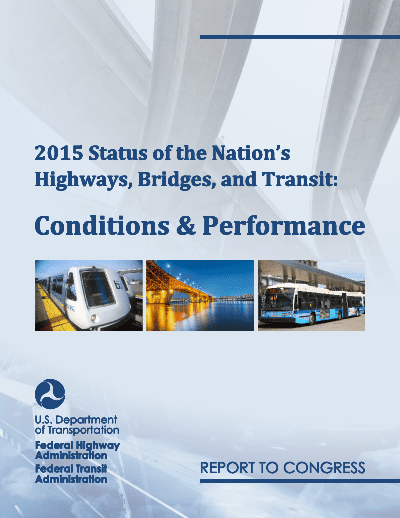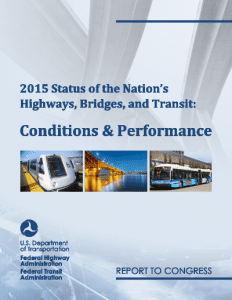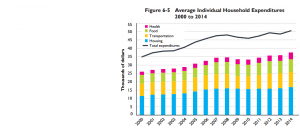January – February 2017 TRENDS

USDOT Report: America Needs $926 Billion Infrastructure Investment

U.S. Transportation Secretary Anthony Foxx announced that a January 2017 report on the state of America’s transportation infrastructure, “2015 Status of the Nation’s Highways, Bridges and Transit: Conditions and Performance,” confirms that more investment is needed not only to maintain the nation’s highway and transit systems but to overcome a nearly trillion-dollar investment backlog.
“We have an infrastructure system that is fundamental to the nation’s economic health, and it needs greater attention and resources,” said Foxx. “Improving our nation’s roads, bridges, and transit helps create jobs, connects communities and ensures that our nation is equipped for the future.”
Foxx added that the Congressionally mandated report confirms projections outlined in “Beyond Traffic,” a U.S. Department of Transportation study issued in early 2015 that examined the challenges facing America’s transportation infrastructure during the next 30 years, such as a rapidly growing population and increasing freight traffic.
The new report identifies an $836 billion backlog of unmet capital investment needs for highways and bridges—about 3.4 percent more than the estimate made in the previous report. In 2012, the most recent year in which the report’s data were available, federal, state and local governments combined spent $105.2 billion on this infrastructure—35.5 percent less than what’s needed to improve highways and bridges.
“The case for more investment in our nation’s transportation system is clear,” said Federal Highway Administrator Gregory Nadeau. “A strong transportation system will make businesses more productive and freight shippers safer and more efficient while improving America’s quality of life.”
Access the full report at www.fhwa.dot.gov/policy/2015cpr.
Building Cost Index Reflects Strong Market Conditions

Turner Construction Company announced strong results from the fourth-quarter 2016 Turner Building Cost Index, which measures costs in the non-residential building construction market in the United States. The index, which the company has been regularly preparing for more than 80 years, found in its latest installment that the U.S. construction market continues to experience broad growth, with the West and Southeast regions seeing more significant gains, and the Northeast and Central regions seeing more moderate gains. In addition, although raw material prices remained flat, they have experienced an overall gain in 2016. Fabricated material prices saw continuous growth this quarter.
“The shortage of skilled labor continues to be a key factor in cost increases across the construction industry,” said Attilio Rivetti, the Turner vice president responsible for the Cost Index. “As we move into 2017, we expect this focus on skilled labor to intensify, especially as the market remains busy.”
Obama Signs Water Infrastructure Improvements into Law
In December 2016, U.S. President Barack Obama signed into law the Water Infrastructure Improvements for the Nation (WIIN) Act, which includes provisions of the Water Supply Cost Savings Act as well as the Water Resources Development Act of 2016.
Receiving strong bipartisan support, WIIN authorizes water projects across the country to restore watersheds, improve waterways and flood control, and improve drinking water infrastructure. The law also authorized $170 million for communities facing drinking water emergencies, such as Flint, Mich., and the lead contamination in its drinking water system.
“This new law will help rural and small communities across America significantly lower the total cost of providing clean drinking water to residents as well as provide new jobs,” said Steve Anderson, Water Systems Council president. “The fact that these communities can realize up to a 75 percent cost savings by using water wells vs. municipal pipeline systems demonstrates that we can cost-effectively meet our nation’s critical water needs while supporting domestic manufacturing and jobs.”
The fourth-quarter 2016 Turner Building Cost Index increased to a value of 1006, a 1.11 percent increase from third-quarter 2016 and a 4.9 percent yearly increase from fourth-quarter 2015.
Transportation Economic Trends Report Released

The U.S. Department of Transportation’s Bureau of Transportation Statistics (BTS) released Transportation Economic Trends, its first standalone volume on transportation and the economy. The 94-page report uses a variety of data series to highlight relevant trends and explain related measurement concepts.
Topics covered in the report include the Transportation Services Index, a monthly summary of freight and passenger movement; what transportation contributes to the American economy; the costs that households and businesses pay for transportation; transportation-related employment; trends in transportation productivity; household spending on transportation goods and services; government transportation spending and revenue; and the value of transportation.
The report, which can be accessed at bit.ly/2jNy1pF, will be regularly updated on the BTS website.
Research Project Seeks to Reduce Carbon in Construction Supply Chain

The Carbon Infrastructure Transformation Tool (CITT) project started from the desire to solve two key problems facing the construction industry: 1) greenhouse gas emissions and 2) the highly fragmented nature of supply chains. A collaboration between the University of Edinburgh Business School and Costain Group (and funded by the Construction Climate Challenge), CITT seeks to develop and implement a tool that will help construction companies identify and reduce carbon through innovation and supply chain engagement.
“The tool will be integrated into current pricing processes and will allow us to have carbon and cost together,” noted Damien Canning, head of technical sustainability at Costain Group and industry specialist for carbon management for CITT. “It will put the data in the hands of the right people at the right time in contractors’ processes, which will allow them to make decisions to significantly reduce carbon. It will also push carbon further back toward the start of the design processes.”
The project is running for three years, and research will focus on carbon accounting methodologies, stakeholder engagement and social barriers to tool adoption, collaborative frameworks for efficient supply chain management, and decision analytics for project design under uncertainty. There will be close collaboration between researchers and the construction industry, and live tests have been set up with real infrastructure projects.
“The way to really drive this is to develop something with as much input from the industry as possible,” added Canning. “This will help raise standards significantly and ensure consistency across the industry.”
TOP Stories
The following are the top stories from the last few months (in terms of traffic) on the Informed Infrastructure Website. This also reflects key coverage areas that are regularly refreshed online and via our weekly e-newsletter. Simply search key words on Informed Infrastructure online to find the full story.
Buildings
• Adolfson & Peterson Construction Breaks Ground on New UNC Campus Commons
• WakeMed North Family Health & Women’s Hospital Expansion Project Wins Best in BIM Award
• How Safe Are Our Crumbling Bridges and Vulnerable Buildings?
• New $32.4 Million Elmhurst Community Library Opens
• Renovation of Buildings Considers Climate, Improves Economy and Creates Value for Citizens
Transportation
• Rapid Reconstruction Method Used to Replace Rhode Island Bridge
• Oklahoma Interstates and Highways Designated as Alternative Fuel Corridors
• Amsterdam and TomTom Join Forces to Create a Smarter City
• ITD Engineers Find $700,000 Savings, Traffic Efficiencies in Replacement of Owsley Canal Bridge
Water
• Milbank Advises Lenders in Historic $920 Million Water Pipeline Project for San Antonio
• New Study Reveals Costly $14B Water Risk to Business
• Komax Triple Action Static Mixer Answer to Desalination Problems
• The Growing Need for Advanced Water Treatment
• How Data and Analytics are Keeping Philly’s Water Safe
Tools and Technology
• AssetWise Completes Bentley’s CONNECT Edition
• Microdesk Reveals Top Trends for 2017 that Will Impact AECO Industry
• IMAGINiT Technologies Acquires Autodesk Business from Eagle Point Software
• Four Nemetschek Group Brands Win Digital Building Transition Award in France


